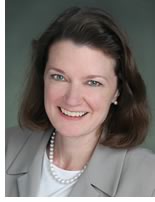

4/2006
Urban designer Martha Welborne, FAIA, to talk about her unusual experiences

This annual dinner celebrates the contributions of women to the architecture profession and specifically the achievements of women elevated to the College of Fellows. Keynote speaker Martha Welborne, FAIA, is managing director of the Grand Avenue Committee, a public/private partnership focused on revitalizing the cultural and civic districts of downtown Los Angeles through the creation of a $1.8-billion project that includes six high-rise buildings and a 16-acre civic park. She was also project director of the Surface Transit Project, an initiative that led to the creation of Los Angeles County’s Metro Rapid bus, one of the most successful new transit systems in the country. She was appointed a Loeb Fellow at Harvard University’s Graduate School of Design in 1991 and elected to the AIA College of Fellows in 1993. Here is what she has to say about her upcoming keynote speech.
 I
am going to title my talk “Out of the Box,” because the work
that I have been doing since I moved to Los Angeles 12 years ago has
been an unusual approach to being an urban designer. I have been able
to do this partly because of the way Los Angeles operates, how it’s
open to new ideas, how it lets people come here and contribute ideas,
and then absorbs these ideas and runs with them. I’m going to illustrate
two examples of that. One is the project I’m currently working
on, the Grand Avenue Project. The other example is to be the creation
of the rapid bus system here in Los Angeles. Both of these I’ve
done operating as a nonprofit, working in one case on my own, and in
the other with a group of civic leaders. In both cases, the effort is
to do the work the government can’t do and urge the government
to undertake projects that we think are very worthy.
I
am going to title my talk “Out of the Box,” because the work
that I have been doing since I moved to Los Angeles 12 years ago has
been an unusual approach to being an urban designer. I have been able
to do this partly because of the way Los Angeles operates, how it’s
open to new ideas, how it lets people come here and contribute ideas,
and then absorbs these ideas and runs with them. I’m going to illustrate
two examples of that. One is the project I’m currently working
on, the Grand Avenue Project. The other example is to be the creation
of the rapid bus system here in Los Angeles. Both of these I’ve
done operating as a nonprofit, working in one case on my own, and in
the other with a group of civic leaders. In both cases, the effort is
to do the work the government can’t do and urge the government
to undertake projects that we think are very worthy.
I think for all of us, our goal as architects is to be as instrumental as we can be in improving the world and changing the environments we live in at whatever scale we choose to work. Mine happens to be the urban scale. I’m hoping that the people who will attend will learn new ways that they can work in their own city or, if nothing more, then they’ll see two examples of interesting projects!
An “unusual way of working”
When I first moved out here, I was managing director of Skidmore Owings
and Merrill’s Los Angeles office. They decided in 1996 to radically
downsize, and there was some thought I would move to San Francisco.
Instead, I went out on a limb and got a grant to help create a better
transit system in Los Angeles. I had the idea that a rapid-transit
system like the one that was built in Curitiba, Brazil, might make
a lot of sense for Los Angeles. The Los Angeles subway is not as extensive
as in many other cities and not nearly as extensive as we need for
the spread of the city and county here. And the cost of building more
subway is nearly $300 million per mile. In Brazil they had created
what they call a surface metro, where long rubber-tired buses mimic
a light-rail line.
I started by introducing this concept to the MTA board and the mayor at the time, Dick Riordan. I started operating as a 501(c)3. I got a grant from a foundation and plunged in and started calling people up and ended up taking several delegations down to Brazil to see this system. I worked hard with the MTA board and staff to test the concept and see if it was of interest. We did a lot of behind-the-scenes design work to test the ideas and a lot of community work and computer simulation videos to show how it might work. The long and the short of it is that, in partial form, the system is now up and running and out there in the streets and helping people. I got the grant in 1996, I started in earnest in February or March of 1997, and the first demonstration routes were operating in June 2000. Since then it has grown exponentially.
That gave me the confidence for working in this mode as a nonprofit by contributing ideas. I sell the idea to a foundation and the foundation pays for my work. I try to translate and test these ideas with the government. If they want them, they can take them, and if they don’t, that’s fine, I just move onto the next project.
Grand Avenue Committee
The Grand Avenue project is a $1.8 billion project that will include
3.6 million square feet to be located on five parcels of three city
blocks. It will comprise six high-rise buildings and about 600,000
square feet of retail, including restaurants, bookstores, food markets,
galleries, health clubs, and a variety of entertainment spaces that
complement the existing cultural facilities at the top of Los Angeles’ Bunker
Hill. The first phase of the project, well under way in design, is
by Frank Gehry and will be located directly across the street from
his Walt Disney Concert Hall.
We’re also improving a 16-acre park and improving the streetscape to create a better pedestrian environment. We think of this as the northern anchor to a lot of the growth that is going on downtown. To create this project, the nonprofit set about urging two governmental bodies to create a joint-powers authority, a merger of the county government and the community redevelopment agency, which jointly own the land. We realized from the start that if we didn’t get the two governments to work together, it would really be hard to pull off a project where the whole is much greater than the sum of its parts, and that was our goal.
These are two different examples, two ways of operating as a nonprofit with different funding sources, different types of projects, and both involve urban design.
Responding to the city
In every city I’ve lived in, I’ve worked in different ways,
and part of that is a response to the city. If you want to improve the
city you live in, even if it’s a part-time pro
bono activity, I
think you adapt to the way the power structure is established and how
your skills complement other people’s skills. Some of this I think
is because Los Angeles is what it is. It’s not just because I am
who I am. A lot of it is the openness of the city, the need for urban
designers, and the access to the power structure that good ideas bring.
There is a certain element of risk, but all architects take a lot of
risks all the time, and a lot of them might not think about it that way.
But in private practice it’s constantly a risky proposition. You’re
constantly trying to bring in new work. This way of working is not much
different than that.
What to do in Los Angeles?
It’s great that the convention is coming here. There’s so
much great new architecture in Los Angeles. If I had one afternoon off,
I’d go to a matinee at Gehry’s Walt Disney Concert Hall.
Merging the music and the architecture is the best way of experiencing
that building. There is also Raphael Moneo’s Our Lady of the Angels
Cathedral, and, for those who haven’t seen it, Richard Meier’s
Getty. The Getty Villa, restored by Machado and Silvetti Associates,
is now open. It is a beautiful restoration and extension of the Getty
Villa in Malibu. Then there are actually a lot of fabulous historic buildings
here that I’m sure are on some of the tours and featured in some
of the seminars. For those who don’t know the Bradbury Building,
it’s one of the most amazing buildings I’ve ever been in.
It’s hard to pick one thing to do!
Copyright 2006 The American Institute of Architects.
All rights reserved. Home Page ![]()
![]()
All are welcome to attend the Women in Architecture dinner.
For more information, including tours, visit the AIA 2006 National Convention and Design Exposition Web site.
![]()